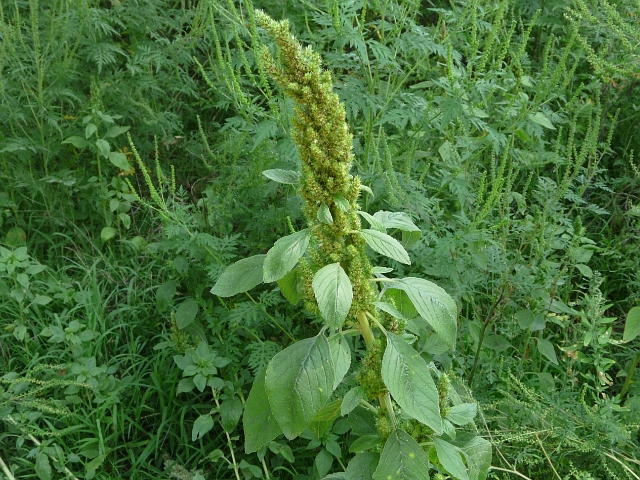(from Toronto Wildlife)
Food:
"They (amaranth seeds) were still being collected and eaten or ground with meal and steamed at Acoma, Laguna, Zia and Zuni pueblos well after the turn of the century. --- Over time amaranth greens probably played an even greater dietary role-and with good reason, for the stems and leaves contain amino acids, vitamin A, caloric food energy, and various other essential nutrients comparable to and sometimes greatly exceeding those of domestic spinach.
---In our area (northern New Mexico) ,amaranth stands among the 'big four' of wild plant greens available for the picking throughout the summer, the others being beeplant, goosefoot, and purslane". (Dunmire and Tierney 175)
"Raw or cooked. Mild flavor. Fresh leaves are good in salads, tacos, rice dishes, and on sandwiches. Cooked in omelets, lasagne, soups, and egg rolls. Roasted lightly, seeds may be ground into flour or boiled as a hot cereal. Seeds may also be popped like popcorn, or sprouted. Harvest and chaff with gloves (the chaff is somewhat spiny), and winnow chaff from the seed using the wind." (Seebeck 13)
Recipe 1: Green Juice
"Harvest leaves from a variety of wild greens like dandelions, thistle, amaranth, wheatgrass, yarrow, or whatever you find growing. (NOTE: Harvesting just a couple of leaves per plant does not harm the plant.) Place all leaves in a blender filled with good water. Blend on high until greens are pulverized, about 2 minutes. Strain and retain the green juice. Store in a glass jar with a lid in the refrigerator for a day or two. Drink one or more times per day, especially before meals. Best to sip slowly about 30 minutes before eating." (Morgan 130)
Recipe 2: Amaranth Leaf Quesadilla
"Start with a large, very soft whole-wheat tortilla. Lay tortilla out on a cutting board, and cover half with a layer of cleaned, chopped amaranth leaves. Cover with cheese or cheese substitute. Add sliced tomatoes and fresh chopped garlic. Sprinkle with fresh ground pepper.
Heat 1 tablespoon olive oil in large skillet. Fold empty side of tortilla over side with filling. Place in hot skillet and fry over mediun-high heat until just brown. Flip and repeat until the other side is lightly browned. Remove from heat and cut into pizza-like slices. Sprinkle truffle oil lightly on top; sprinkle with salt if desired.
Variation: Use organic corn tortillas instead. Corn tortillas are usually small. If using corn tortillas, do not fold in half. Instead, lay one tortilla out flat. Place amaranth leaves, cheese, and other fillings inside. Cover with another tortilla. Fry in pan as described." (Morgan 130)
Medicine:
"The main function of Amaranth is as a pleasant, mild astringent for the mucus membranes. A strong tea (tablespoon of chopped leaves in a cup) can be drunk every several hours for mild stomach and intestinal irritation, particularly the recuperative period of gastroenteritis or stomach flu to lesson irritability of the tissues. It will aid in mild diarrhea and hemorrhoid and pile inflammation. A douche made with a handful of the leaves in a pint of water will aid vaginal itching and inflammation without accompanying discharge. A few dried leaves and a teaspoon of lavender flowers or chamomile flowers steeped for ten minutes in hot milk and cooled can be given to an infant with colic or ejectile vomiting. The fresh plant has little medicinal value, other than using for cooling poultice. Only the dried plant has an appreciable amount of astringency." (Moore 24)
History:
"The historical records show that much of the amaranth collected was used for ceremonial purposes, unlike maize and beans which were largely collected for consumption. An oft noted ceremony is one honoring the god of war — Huitzlipochtli. The deity’s image was created from a combination of amaranth grains and honey, and after much celebration culminating in human sacrifice the image of the god was broken into pieces and distributed to the people to eat." (Whole Grain Council)
Internet Resource
